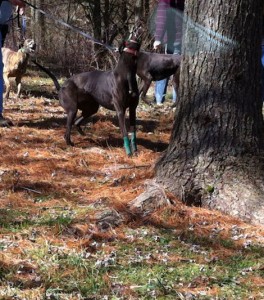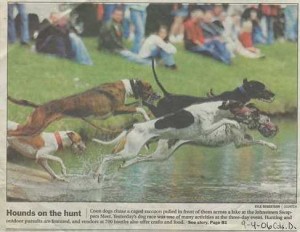FIELD TRIAL RACING IN THE MIDWEST

Non-sanctioned backyard racing, also known as field trial racing got its start in the 1940’s and became more organized and widespread in certain parts of the country by the 1970’s. Today, lurchers are still commonly used for field trial racing in the Midwest. The races are held in many states – Oklahoma, Kansas, Missouri, Illinois, Indiana, Michigan, Ohio, Pennsylvania, and western New York. The sport of field trial racing has become a tradition in small towns in rural America. The people racing the dogs call themselves field trialers.
Are Greyhounds Used in Coon Dog Field Trials?
For the coon-dog field trials that are sanctioned by the various kennel clubs that register coon-dogs, only registered coon-dogs are allowed to compete. But for the open class “coon-dog” field trials that are run for cash purses, like the races in Lima, Ohio and other events, the dogs used are almost all greyhounds or greyhound crosses.
Unfortunately, many of these dogs are kept outside, chained up to small wooden houses, and far too many are either abandoned after the field trials or races — either in the woods, at county shelters, or disposed of when they are injured or are no longer fast enough to make money for their owners. In the past, lurchers have been largely ignored due to so many retired NGA greyhounds flooding into Greyhound Adoption groups. The typical Midwestern lurcher is the result of a NGA registered Greyhound, or what the field trialers call a full-blood, being bred with a Coonhound and are usually 7/8ths Greyhound and 1/8th Coonhound. If you ever wondered why some of the lurchers have shorter tails, it is because the breeders dock their tails when they are puppies. Today’s lurchers are descendants of many famous NGA dogs like Sweet Gypsy Rose, Red Riot, Dodgem By Design, and many more. Here is one field trialer’s telling post: “Looking to buy a greyhound brood bitch out of Dodgem By Design. Email me at XXXXXX” (phone number redacted). The Midwestern lurchers are commonly used in field trial races which involve treeing a raccoon. The dogs are called tree dogs. Field trial events are held at sportsman hunting clubs, on private lands, and at county fairs.
The dogs are raced on short and long tracks with the 5/8ths mile track being the most popular. Underground races are scheduled all year around. You can find a scheduled race in the Midwest nearly every weekend. The dogs attend two-day race meets and are entered in multiple heats and compete for prize money. There is no set retirement age and they are raced until they start losing races.
Training involves a practice called “roading,” where the dogs are on a rope and forced to run alongside a moving vehicle. The dogs are sometimes injured, get tangled up in a wheel, or accidentally run over during training.
For many years, lurchers have been showing up at county shelters all over the Midwest. Greyhound adoption groups, all breed rescues, and individuals have helped many of the lurchers find wonderful loving homes.
Note: To clarify, AKC and American Field Trials traditionally involve bird dogs and other registered hunting dogs and have been a long-standing tradition in the United States.
What is Water Dog Racing?
 Have you ever been traveling down the highway and noticed a truck or motor home pulling a strange looking trailer with three or four doors on each side? Then you notice there are paws and noses sticking out of the doors and realize that there are dogs in there.
Have you ever been traveling down the highway and noticed a truck or motor home pulling a strange looking trailer with three or four doors on each side? Then you notice there are paws and noses sticking out of the doors and realize that there are dogs in there.
The dogs entered in these races are usually a mixed breed of hound. There are no breed standards at these kind of events. Many of the dogs have a lot of greyhound in them mixed with some sort of coon dog breed. These breeds are not registered dogs, but are used for water racing, a dog sport where seven or eight dogs are lined up at the end of a pond in what is called a starting box. Each dog is assigned a colored collar to wear and the dogs go into a matching colored box. A small float with a raccoon is pulled in front of the dogs before it hits the water. The float with the coon takes off across the water by some kind of a pulley system. Then someone releases the cage front of the starting box allowing the dogs to run a few steps before plunging into the water after the raccoon. Sometimes the dog fight each other in their excitement. The owners have to get to the other side of the pond to catch their dogs.
There are two winners in every race, first line and first tree. Winners are determined by a line stretched across the other end of the pond. The first color to have his nose cross under the line wins first line. The next winner is the first to come out of the water and cross a set line on the bank. Crossing this line does not ensure a winner for first tree, the dog must bark to be the winner.
Preliminary race winners are grouped together for the final race. Only the first line and tree winners advance to this event. The finals are swam exactly as the normal heat races only there are two line winners and two tree winners for each final.
The payout for the winners is a predetermined set amount or by how many dogs was entered into the preliminary heat races. Each dog owner has entered the dog name, the class they would like to swim in, and have paid an entry fee.
Anyone with a dog who can swim can enter at these meets whether they are registered breeds or not.

